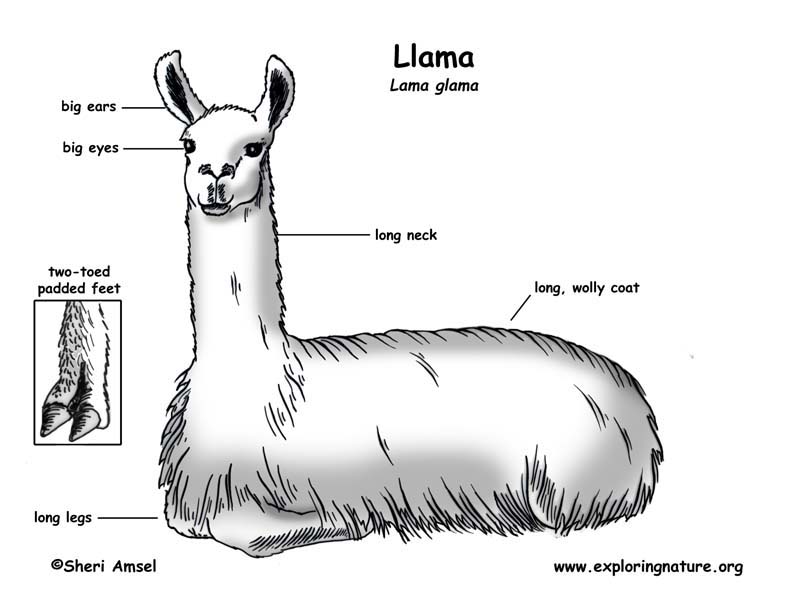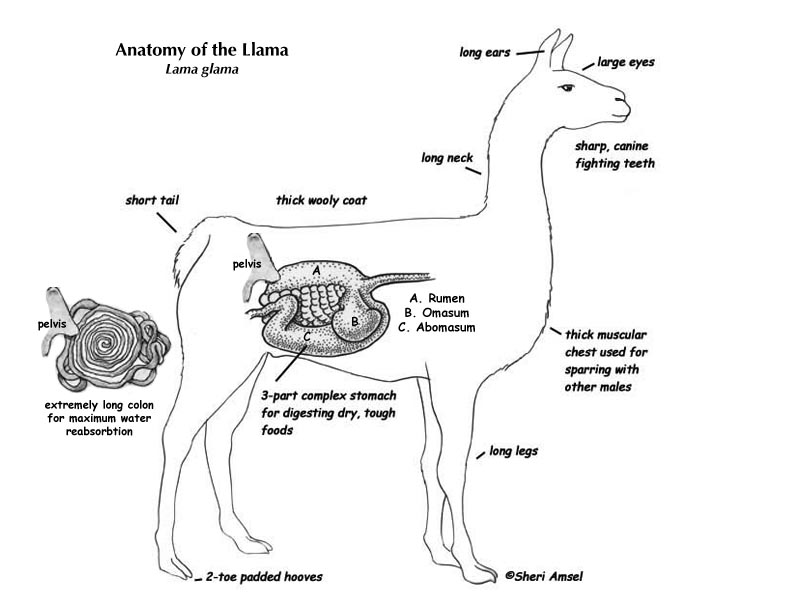

They are found in the Andes Mountains in South America. Llamas are almost completely domesticated now. Very few can be found in the wild. They have been imported into the United States and Canada for breeding and are now commonly found on farms all over North America.
They live on the highland plateaus that are covered with grasses, brush and small trees.
They are the largest of the camels that live in the Western Hemisphere, including alpacas, vicunas, and guanacos. They weigh from 250-350 pounds and reach 6 feet tall. They have long necks and large ears and eyes. They have long legs and a long shaggy coat. They have no upper front teeth (incisors), but do have sharp canine teeth that llama owners often file off to prevent injuries during male dominance scuffles in a herd. Their hooves are made up of two toes with a leathery bottom (split-hooved feet). They can be any color from white to black, solid colored or spotted.
They live in groups and can be very possessive about their living space (territorial). Because of their territoriality, they are often used to protect flocks of sheep. They will drive off dogs or coyotes with a forceful chest thrust or biting with their sharp canines. They have a loud alarm call too, which can inform farmers when predators are nearing their flocks. If alarmed or angry, they lay their ears back and spit cud. When they see something familiar, like a bucket of food coming their way, they actually may hum. They are curious by nature and will “nose” things that interest them, including people.
They eat shrubs, plants, leaves and grasses (herbivores), which makes them browsers instead of grass grazers. They are ruminants. This means that they can eat dry grasses and digest it with the help of a 3-part stomach. Microorganisms (bacteria and protozoa) in the stomach help break down the dry parts of the grass (cellulose). Then the llama spits up or "regurgitates" the food back into the mouth and chews it again. This is called chewing their “cud” and further helps to break down the tough grass.
Their predators are coyotes, dogs, mountain lions and man.
Males gather 6 or more females together (harem) and protect the area where they live from other males and predators. The females are pregnant for about 11 months (gestation) and have one baby a year.
They can live 15-20 years in the wild. They are not a threatened species.
Kingdom: Animalia
Phylum: Chordata
Subphylum: Vertebrata
Class: Mammalia
Order: Artiodactyla
Family: Camelidae
Genus: Lama
Species: Lama glama
When you research information you must cite the reference. Citing for websites is different from citing from books, magazines and periodicals. The style of citing shown here is from the MLA Style Citations (Modern Language Association).
When citing a WEBSITE the general format is as follows.
Author Last Name, First Name(s). "Title: Subtitle of Part of Web Page, if appropriate." Title: Subtitle: Section of Page if appropriate. Sponsoring/Publishing Agency, If Given. Additional significant descriptive information. Date of Electronic Publication or other Date, such as Last Updated. Day Month Year of access < URL >.
Amsel, Sheri. "Llama" Exploring Nature Educational Resource ©2005-2024. December 14, 2024
< http://mail.exploringnature.org/db/view/382 >


